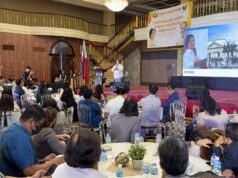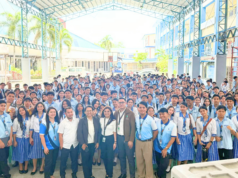To facilitate the process of performance management, we clustered the LGU departments according to the five performance areas namely Governance, Administration, Social Services, Economic Development, and Environment.
On the other hand, MSGC member organizations were clustered into six sectoral committees: Health; Education, Culture Preservation and Sports; Trade, Industry and Economic Development; Transportation, Communication and Infrastructure; Public Safety and Order, and Environmental Management.
Clustering enables us to carry out our strategy in a unified way because cluster members generally share common beneficiaries. In this manner, the time, money, effort and other logistics are spent on initiatives that go beyond the scope of only one department or organization. With other cluster members implementing the same initiative, the project then bears more impact on the lives of our constituents.
Let me cite an example. The City Government needs to update San Fernando’s socio-economic profile. Instead of using available manpower or hiring new ones to conduct the needed research, the LGU got a major university, also an MSGC cluster member, to agree to deploy its students not only to gather data but also to conduct a general census in all barangays. With this, we will be involving the academe in something that would significantly benefit the whole city while managing LGU resources satisfactorily.
Some time later, after an LGU-MSGC interfacing workshop, both the LGU and the MSGC uniformly adopted clustering according to the BSC’s perspectives of Constituency, Organization, Finance and Infrastructure. Each LGU and MSGC cluster regularly meets. Each is headed by a chairperson who sees to it that members remain on track while carrying out their individual organization’s initiatives in support of the city’s objectives.
Planning of initiatives is done during workshops when BSCs are prepared by the different departments, offices, units and, ultimately, the employees. In all instances, the strategy on the City Scorecard remains the focus of all initiatives.
Through Interfacing
Cluster departments in the LGU work to arrive at common initiatives through interfacing. The City Government’s executive team also meets with the MSGC every two months to resolve concerns and interface on their strategic initiatives.
This process entails, as it always should, focus on the strategy and not on individual programs and projects. Through interfacing, opinions are elicited and accomplishments are validated vis-à-vis the Balanced Scorecard. Through interfacing, we avoid duplication of initiatives and can channel effort, time and expenses towards the delivery of other services.
An example of this is the LGU’s breastfeeding station project. During an interfacing workshop, the City Health Officer reported on the establishment of breastfeeding stations in the city. The MSGC’s committee on health also had a similar initiative, the Milk Bank Program. Through interfacing, both agreed that the LGU provided the physical structure and manpower at the breastfeeding station while the MSGC networked for the station’s furnishings and the refrigerators to store mothers’ milk in. You can see how both parties benefit from the process and the arrangement.
With the OSM
The Office of the Strategy Management (OSM) was created on May 2, 2007 through an executive order. Initially, the OSM was manned with interim staff that performed monitoring functions only in addition to their official duties in their respective departments. But given the important tasks of the OSM and its crucial role in overseeing strategy execution, we assigned full-time personnel who did real OSM work. Last May, they conducted a series of BSC reviews and conducted one-on-one consultations, workshops and personnel orientation on the BSC. These resulted to1) updating of the City Scorecard and MSGC Scorecard 2) alignment of 22 Department Scorecards with the renewed BSC strategies3) BSC cascading to frontline providers, and 4) Establishment of various mechanisms for data validationThe OSM is primarily responsible for defining the framework for strategy management for both LGU and MSGC. It designs and oversees the entire management process, tracks the progress of strategy execution and makes recommendations to the City Mayor based on findings. For example, one of OSM’s findings is the need for real documentation within the LGU. The scorecard has metrics that need to be quantified. As we say, one cannot manage what one cannot measure. So, the OSM is now in the process of designing a monitoring scheme that will yield in the near future, all the data needed to evaluate programs and projects for better and effective strategy management.It is the job of the OSM to see to it that the whole organization is aligned to the strategy. It must ensure that everything – human, financial, information technology, processes – is linked to the strategy. It also plans on how to communicate the strategy to the employees and to the public for their understanding and support.
SUMMARY
With transparency and performance management, we have achieved results in making San Fernando a livable and sustainable city.
Streamlined and ISO-certified, our regulatory processes find high customer satisfaction. So do our other basic services that have improved through personnel trainings.
Program innovations have been reached like our holistic approach in TB treatment. TB patients are not the only ones benefiting from our anti-TB program, the Kalingang Fernandino. Their families also do from our package of health, social and livelihood services that go with the program.
We continue to invest in Human Capital with better recruitment processes, and trainings of LGU personnel.
By nature of its topography, San Fernando is flood-prone. So now we face and check risks of flooding through our river restoration program. SAGIP ILOG provides an integrated framework of strategies that covers not only water, our most important resource, but also the improvement of living conditions of affected families. We developed an integrated relocation program for them. We build and maintain flood-control infrastructure. We generate economic opportunities by creating business parks and transport terminals. And we are reaching out to neighbouring towns affected by this undertaking. Because of the holistic vision of SAGIP ILOG, the City has attracted support and assistance worth nearly P600M from Japanese financial institutions.
Conclusion
We continue to hold the belief that if we were to make a difference in governance, we first have to make a case for change. As in any case for change, the buy-in of top management is a must. Banking on the authority and power given us by law, we set out to change the culture of patronage politics that many politicians would rather not disturb. For us, it was leading not with personal goals and agenda but from the people’s point of view and, consequently, effecting change.
Despite the many obstacles we encountered in the course of our journey towards PGS institutionalization, these results have come sooner than we expected. As we say, with the PGS, the impossible becomes possible because when one’s sight is focused on a singular vision, many things can happen indeed.
Thank you and have a good day.




